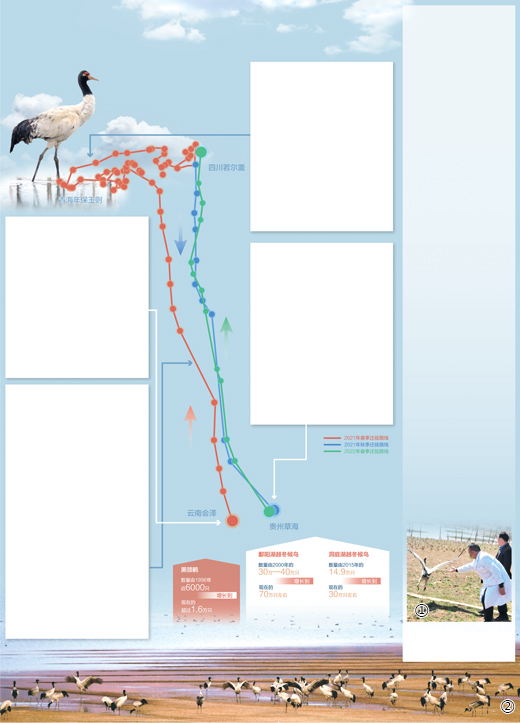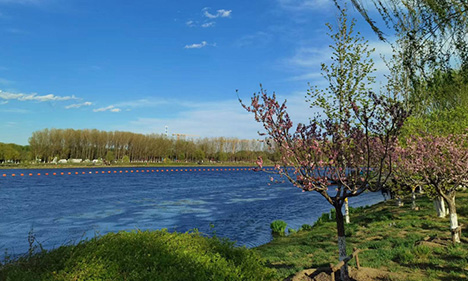Satellite-based tracking of black-necked crane’s migratory routes supports efforts to protect bird populations in China

① File photo shows staff members of the Daqiao zone of the National Nature Reserve of Black-necked Cranes in Huize county, southwest China’s Yunnan Province releasing the black-necked crane with a satellite-based tracker, labeled with the unique tracking number of V021, back into the wild in March 2021.
② Photo shows black-necked cranes in the National Nature Reserve of Black-necked Cranes in Huize county, southwest China’s Yunnan Province in March 2021. (Photo/Zhou Zhaoxiang)
The migratory routes of a black-necked crane, a species under first-class state protection in China, which was fitted with a satellite-based tracker by an assistant researcher in China, reflect the country’s continuous efforts in protecting migratory birds.
The young black-necked crane was rescued by a villager near the Daqiao zone of the National Nature Reserve of Black-necked Cranes in Huize County, southwest China’s Yunnan Province on March 11, 2021. The bird was then delivered to the Daqiao management bureau of the nature reserve, where Zhang Shugang, a guardian of black-necked cranes, took care of it.
On March 18, the crane was then released back into the wild, with a satellite-based tracker having a unique number of V021, which was implanted by Wu Heqi, an assistant researcher with the Kunming Institute of Zoology under the Chinese Academy of Sciences.
Wu introduced that the letter “V” symbolizes victory, hoping that the bird will achieve a successful migration.
It’s the first black-necked crane with a satellite-based tracker to be placed on it by a team from the institute in the nature reserve, said Wu, adding that the satellite-based tracker is more lightweight and can provide more comprehensive information, including the geographic latitudes and longitudes of the bird’s migration trajectory and its flying speeds, as well as the altitudes and ambient temperature of the places it stays.
Wu pointed out that the application of satellite-based tracking technology enables the team to better understand the range of activities and migratory routes of black-necked cranes so that better-targeted protection can be ensured.
The team has applied the technology with over 100 birds, including more than 10 black-necked cranes. According to monitoring data, there are primarily three isolated wintering communities for the species in China: the eastern community winters in areas between the Yunnan-Guizhou Plateau and provinces including Sichuan, Gansu and Qinghai; the central community winters in areas between Bitahai and Napahai lakes in Yunnan and high altitude areas such as Daocheng in Sichuan; and the western community winters in areas between the Yarlung Tsangpo Grand Canyon in southwest China’s Tibet Autonomous Region and high altitude areas of the Qinghai-Tibet Plateau.
The tracking result showed that Dashanbao in Zhaotong city of Yunnan is an important migration station along the eastern flyway, which indicates the effective protection of the birds along the flyway, Wu said.
The black-necked crane with the V021 label is now at the eastern flyway. As of April 19 this year, the crane had stayed over 10 days in the Ruoergai wetland in Sichuan along the eastern flyway. One year ago, the crane stayed more than one month in the Nianbaoyuze national nature reserve in Qinghai.
“It’s a new finding thanks to the monitoring of the V021 crane. In the past, we didn’t know that the eastern community of black-necked cranes would fly to Nianbaoyuze,” Wu said.
The Nianbaoyuze national nature reserve is an important breeding ground and habitat for black-necked cranes in Qinghai. The local ecological environment has improved significantly in recent years, and the nature reserve has seen a steady increase in the population of black-necked cranes.
In early November 2021, the V021 crane migrated south and arrived at the Caohai National Nature Reserve in Guizhou.
Since black-necked cranes have difficulty searching for food in cold weather, the birds will often eat seeds sowed by farmers during the spring farming season, according to Liu Guanghui, deputy head of a patrol team in the nature reserve.
To better address the problem, Liu advises farmers to make scarecrows to frighten the birds away, adding that bird rangers will provide food for the birds. In addition, the management committee at the nature reserve is formulating compensation measures to reduce any losses to local residents caused by wild animals, Liu said.
According to Wu, the protection of black-necked cranes has reached a consensus among all the people living in the birds’ distribution areas. Besides, some localities have developed bird-watching tourism industries while taking precautions to prevent tourists from causing any disruption to the species in an attempt to strike a balance between development and the protection of biological diversity.
“Every year, thousands of visitors come to Caohai to view black-necked cranes,” Liu said, noting that someone might have even taken pictures of the crane with the V021 label.
Photos
Related Stories
- Woman devotes herself to protecting black-necked cranes at nature reserve in SW China’s Yunnan
- Family of three becomes guardian of endangered black-necked cranes at nature reserve in China’s Yunnan
- Black-necked crane population exceeds 8,000 in SW China’s Tibet
- Two men save crane from ice cave and warm it with body
Copyright © 2022 People's Daily Online. All Rights Reserved.










